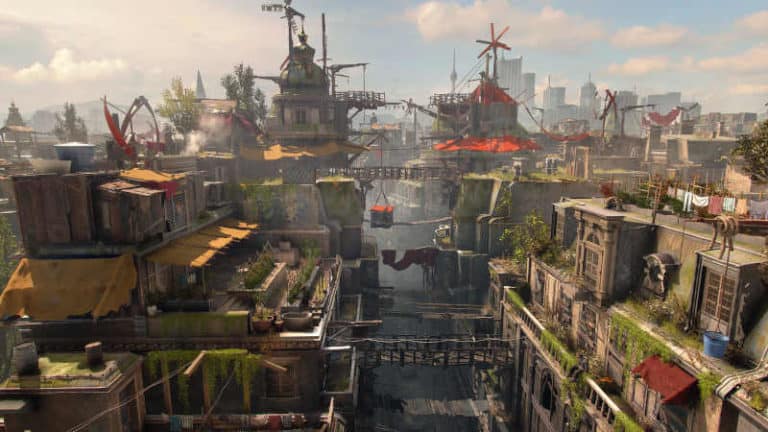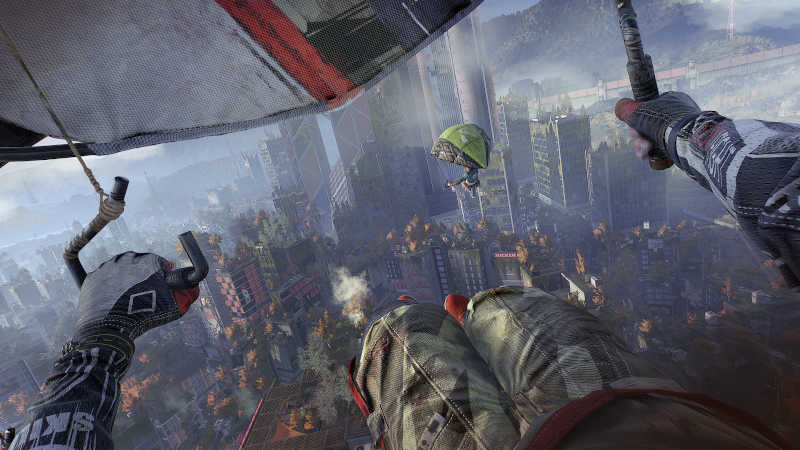After six years, Dying Light 2: Stay Human is finally here. It takes players to a new corner of the world, where the Harran virus has once again escaped. Scientists have been unable to stop the virus, and now the world has succumbed to it. Been there, done that, got the blood-stained shirt, thanks. So, what’s new?
Techland teased Dying Light 2 as an open-world parkour game throughout the game’s development, peppered with story decisions that actually matter. So, how does this sub-genre that Techland made their own stack up against an industry that’s seeing the quality of player agency and influence in a game’s plot and world rapidly increase? is it shoved in haphazardly, or carefully considered? Or better yet, how does it improve it?
Earth 2036: A World ravaged with THV
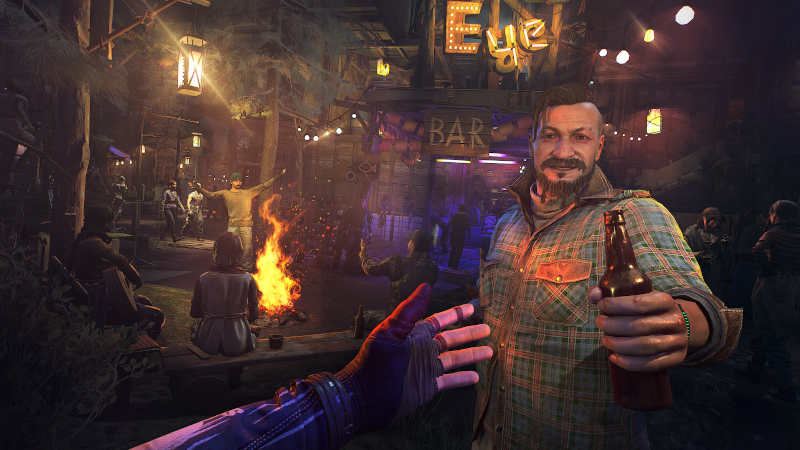
Dying Light 2: Stay Human is set in 2036, where an escaped variant of the THV virus (the virus in Dying Light 1) has ravaged Earth for at least 16 years, leading to the fall of civilization. Now, small pockets of humanity remain, yet, that has not stopped human-on-human conflict.
Aiden, your player-character arrives from outside the city on a personal quest to find his sister, when he stumbles upon a turbulent urban metropolis. Factions, both friend and foe alike, fight for dominance over the city or tensions and animosity force conflict to occur. This is all while human numbers drop every night as the living dead stalk the streets, threatening anyone and everyone, regardless of the flag they fly. This potent cocktail makes the city a tinder keg of issues that you’ll begin to unfurl as you progress. There are obvious inspirations from the Walking Dead, combined with political ambiguity from A Song of Ice and Fire.
Making tough calls is a huge part of Dying Light 2: Stay Human, these can range from donating a territory to a faction, or choosing who lives and dies, with the world shaping itself around you and these choices.
You may find the game’s midpoint and ending are different every time, as the world shapes and reacts to your decisions. Some areas may become closed off, others may become more open. Some characters will help you at key parts of your journey. This reactive world encourages those who love multiple playthroughs a plethora of decision-making options, and new ways to play.
Giving you a reason to go out at night
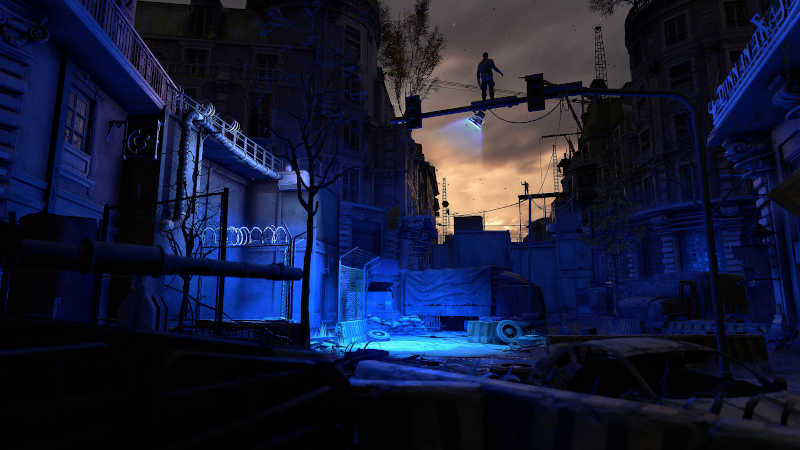
Walking around at night is a struggle that the original Dying Light never managed to tackle. Why would you even want to go out with stronger enemies roaming, when you could just stay in? It’s a problem Techland had with the first game and didn’t want to make it again. So, how did Techland solve this issue?
Going at night still provides risks, but it comes with lots of rewards. Meet the new Howlers, for example, an infected foghorn that triggers a chase with countless other zombies if they detect you, reinforcing those horror vibes.
That’s obviously a risk, but what are the rewards? Well, not going out at night means you skip out on some of the open-world content, which is safer at night and more dangerous in the day. These are reliable ways to get materials for your crafting, and even inhibitors, which are a core part of you’re character’s progression. There’s more obvious and risk rewards decision making to make, rather than sleep it off and you’ll be fine.
However, you’ll more than likely not feel this pressure on ‘Easy’. But, on ‘Normal’ and ‘Hard’, you’ll need to pick up those extra materials and inhibitors to equip yourself in battle, as you’re susceptible to more damage, and enemies can be far more dangerous. It’s good to see that players have clear options on how they want to progress through the game, but if you want a more complete experience, a higher difficulty is the way to go.
The blood and guts of Dying Light 2
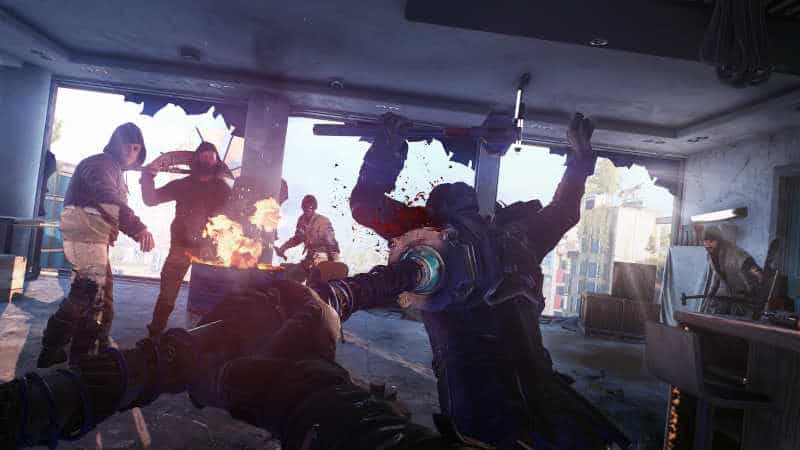
There are plenty of new gameplay features in Dying Light 2, such as the new skill trees. Techland stripped a lot of the boring parts of the old skill tree, removing the uninspired passive percentage increase options, leaving only solid decisions on how you want to play the game. There was simply too much fluff in the last game because of these boring percentage passives, so the new tree is much smaller, but there’s a lot of wow factor now.
The new skill tree points allow you to pick a new ability, whether that is drop-kicking enemies, doing a 360 spin attack with your hammer, or shooting your bow while parkouring. If you got a parkour skill to spend, you will find you can invest them into longer jumps, added dashes while sprinting, crouch jumping, or wall-running as you progress through the tree.
However, not everything is open from the get-go. Your progression eventually gets gated by your total health or stamina, meaning you need to get involved with the gameplay loop of getting inhibitors. Inhibitors are a new feature of the game, which allows you to better contend infection, and allows you to invest in stamina or heath levels. Getting to certain health or stamina levels unlock even more skills for you to unlock. You’ll get some passively as you play through the main story, but a lot of it is through an open-world gameplay loop, such as your excursions into the night, side quests, or accidental exploration. If you opt to play just the main story, you’ll have no issues progressing. But those who brave these secondary challenges will get stronger much earlier on in the game’s story, rewarding these players with an earlier power curve.
In addition to side missions and exploration, you can take on convoy objectives. These are locations that have become overrun, and surrounded by deadly infected. You can take on these during the day, finding creative ways to dispatch the hordes of enemies. You can also stealth your way through, get the loot and bail before they realize, or choose to fight your way through the hordes. You can also get higher-quality loot from more dangerous infected areas, like military zones, Dark Hollow stores, or GRE Quarantine zones, other secondary nighttime activities, but again, that’s if you fancy braving the night.
Unfortunately, it’s not all sunshine and roses. There’s a new class system in the game, which allows player to equip different class gear and get rewards for certain playstyles. There is a Brawler (one-handed melee weapons), Tank (damage mitigation, two-handed weapons), a medic (healing, parkour) and then the Ranger (ranged weapons, stealth, parkour). Brawler and Tank are by far the best in the early game, and for the most part of the early game, Ranger gear is utterly pointless.
Ranged weapons don’t appear to exist in the first part of the map you play through. The only ranged weapon you will come across in the first eight hours are throwing knives. It feels annoying getting ranged gear early as it feels like it is only good for pocketing some cash from a trader. But, rest assured you can get a bow, crossbow, and guns (in a limited capacity) from a variety of sources later on in the game, it just means gritting your teeth if you wanted that gameplay style from the get-go.
Towers? In an open world game?
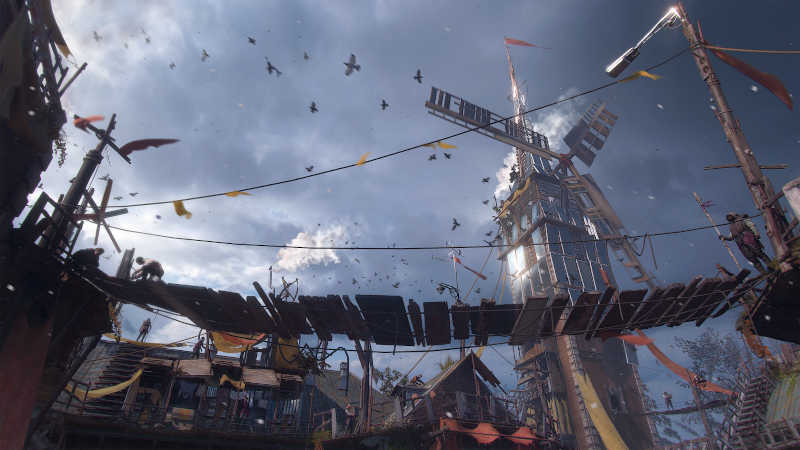
As much as towers in an open-world game are an old and tired cliche (thanks Ubisoft), Dying Light 2’s tower climbing system has a few unique tricks of its own. Radio Towers are a secondary objective that reward players with a catch-up mechanic. Activating one rewards the ability to see inhibitors in a certain region of the map. But, to get to these towers, you’re going to need high-level equipment you get later in the main story.
By doing so, Techland has saved the cliche open-world elements for later in the game, rather than at the start. And the best bit? It is totally optional. In fact, they even joke about that in the prologue, which is a bit cheeky if you ask me.
The other tower-like feature of the game are the game’s windmills. Taking over windmills unlocks new safe areas at night for needed UV lights, which stave off player infection when the sun goes down and ward off zombies, both useful for players braving the night. In addition to this, it also unlocks new settlements that grant new side missions, and vendors to trade with. But, to get them you need to parkour. Some require high-level equipment to scale, while some need higher stamina levels that you can unlock by upgrading your stamina with inhibitors. However, with a bit of creative magic, you can even break the stamina check with some solid parkour, rewarding you for getting creative.
J’adore Parkour
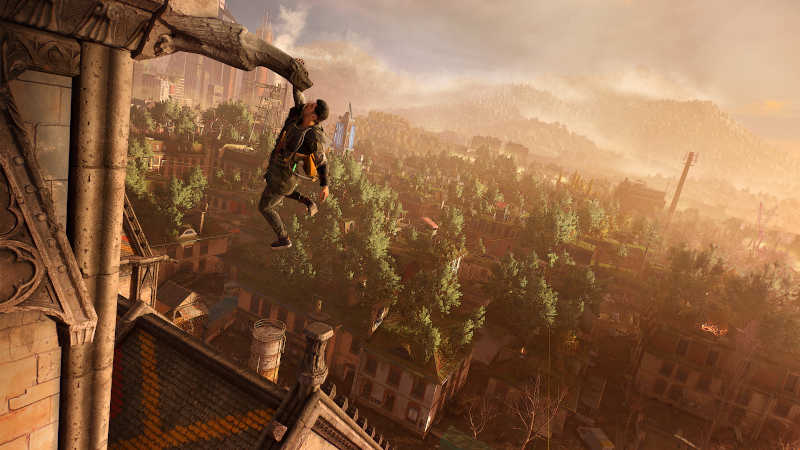
The other pillar of Dying light 2 is parkour, which is what made the game stylistically distinct back in 2015. Six years later, it still holds up incredibly well. At the start of the game, you’re not superhuman, and there are things that will stop or slow Aiden down. But, as you get more stamina and unlock parkour perks, you’ll quickly settle into the satisfying traversal mechanics. Those familiar with Dying Light will settle into the swing of things a little bit quicker than those who haven’t, but there are still new tricks and perks to keep things interesting.
The best examples of game design in Dying Light 2: Stay Human are its challenging parkour environments. There are churches to climb, gargoyles and street lights to grapple, and giant skyscrapers to ascend. In most parts, you can find collectables, or even find upgrade materials that always make it worth your while.
Parkour also allows you to revisit older areas with a fresh set of eyes, overcome obstacles that were once impassable, and also offers you great rewards for doing so, making retracing your steps more of a reward than a chore. The icing on the cake is parkour challenges are back. Throughout the map, you’ll find training courses that you can do time trials on. You can try and beat your own score if you wish, and perhaps even show how good you are against your friends in co-op, too.
THV is not the only bug in Dying Light 2
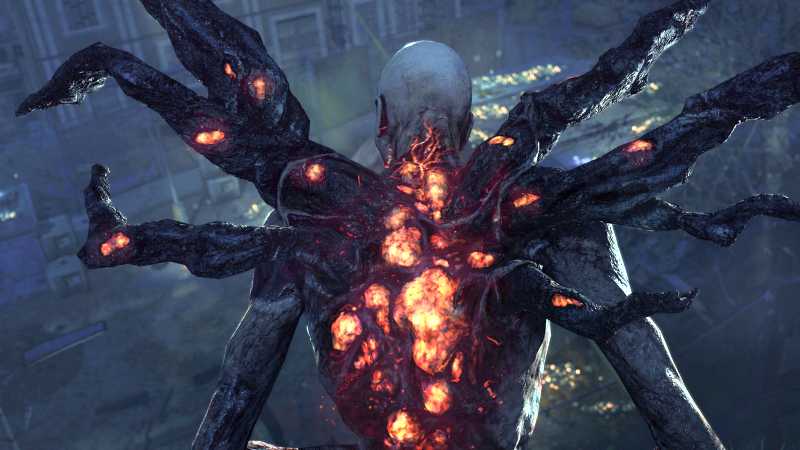
In today’s day and age, a game can live or die on its performance issues. Dying Light 2 is not immune to the endemic launch day problems that plague almost every AAA title. However, we didn’t encounter anything game-breaking, and bugs were virtually nonexistent for the first 20 hours of the game.
There’s only one point that we had to log out of the game and lose our mission progression, which involved a parkour bug in a tight space. There is a handful of minor issues we experienced like dodgy textures, which are easily ignorable.
However, there are a few annoying side effects of the game’s technical demands. The rig we used to run the game had an Nvidia RTX 2070 GPU, I7 9700F CPU and 16GB of RAM. Despite this, we encountered frame drops, which hurled us to our deaths on several occasions. The most notable bit was when we had to drag electric cables during a puzzle. It was even more noticeable on swinging ropes and monkey bars, which is largely where we fell to our deaths at the same speed our frames fell.
The other issue we encountered was when loading into a save. Texture loading was so long we were counting the pixels getting clearer in real-time. That could be largely on us and our HDD, as the game’s recommended system requirements recommend an SSD. After the initial game save loading, we encountered frame stutters and shallow freezes as the game continued to load its open world. It’s quite a hefty load at the start and performance takes a hit. Once all of the assets are fully loaded there are not many issues afterwards.
It’s also worth mentioning this happened on the review build, an update before the embargo lift did largely resolve these issues, and that’s before the NVIDIA Dying Light 2 drivers were even launched. This is probably a non-issue for most people come launch, but it is worth mentioning just in case.
The only other area we really noticed frame drops outside of loading was later into the second part of the map, but that soon faded after a certain mission. How much of these performance problems are optimization issues, or just pure technical demand remains unclear, until more gamers get their hands on it. We are also not in the position to test it again as this was roughly 25 hours into the playthrough when we noticed it.
Luckily, we did speak to Techland prior to writing the review embargo lifting, and we are aware there’s a large day 1 patch coming to address plenty of the technical issues mentioned in our Dying Light 2 review. So, how many of these issues remain by launch still remains to be seen. And, we are also aware that the second patch of the game will fix the parkour bug. Like the Harran virus, Techland has a vaccine in the works for most of these issues. But, we’ll reserve judgement for the final release.
There are also a few other clipping issues too. In one instance we ended up drop kicking a boss out of a fixed state closed window. meaning we were never able to recover its body and loot it. We also find we tend to get stuck in vents or on other sharper-edged objects. Spamming our movements keys got us unstuck, but it still feels a little clunky in those moments that are few and far between.
Dying Light 2 review conclusion
It has been six long years since we’ve had the chance to get our hands on the new way to play the zombie parkour RPG. And it delivered. It has to be said there were some question marks about the game’s quality when stories broke about management issues, creative direction getting hampered, and staff walking out.
However, the game has turned out great in fact. The game is gripping, and the ending of the game drew nearer and nearer, there was cinematics that made me realize the only way this could have happened is because of X, Y, and Z. I did this. If I chose differently, the details on the screen would be completely different. And because of that, the ending I could have got would have been different too.
Those who value player agency driven RPGs will find this game will feed their appetite through several helpings of playthroughs. On the other hand, if you’re impressed by the horror themes and the parkour from the first game, know this Dying Light 2 is even better. Add in all the extra fun coop stuff, a roadmap that lasts five years, and Dying Light 2 is a game that will last a generation.


